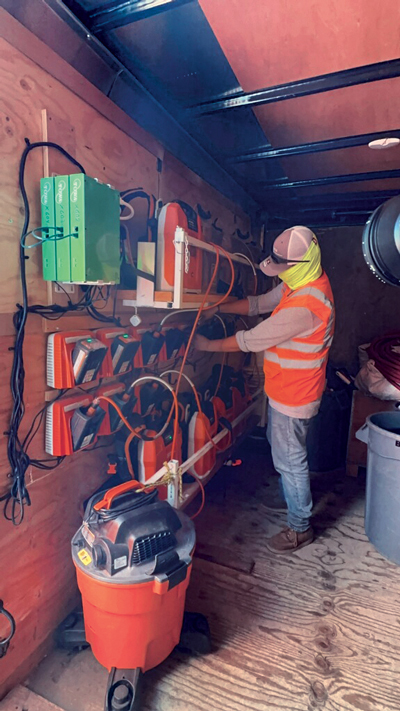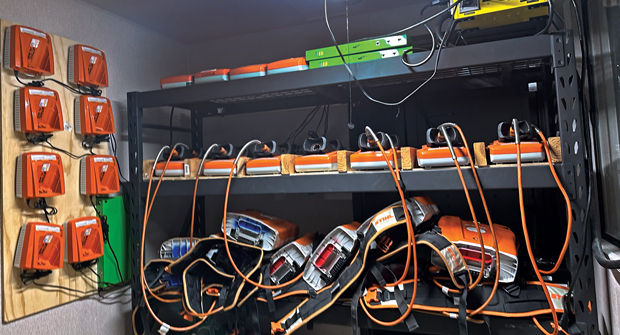The saying goes, “What came first, the chicken or the egg?” In battery-powered equipment, the question is often similar. What comes first: the tool or the batteries?
In fact, it’s those two questions that Paul Beblowski, manager with Stihl, says he fields most frequently about battery-powered equipment.

“We hear two major questions and the first is ‘How many batteries do I need?’ and the second is ‘How do I charge ’em?’” he says.
Beblowski and fellow industry insiders share best practices to help prepare you for the transition to battery.
Know your need
To help contractors understand how many batteries they need, Jason Wilk starts by asking how many tanks of gas they use in a day to power a gas string trimmer. Wilk, a senior product manager for Echo, says string trimmers tend to be consistent in terms of fuel use.
“If it’s two or three tanks of gas, I know one of our 5-amp hour batteries basically provides the same runtime as a single tank of gas,” he says. “If you’re going through three tanks of gas, you’re going to need three full batteries to start your day, or you’ll need one battery to get you going while you maybe have an adapter or charging solution on your vehicle.”

While this equation is helpful, Wilk says the challenge for contractors is scaling the needs for a larger fleet of battery-powered equipment.
“I have a whole crew where I’m going through on 15 trimmers, two tanks of gas a day, all of a sudden you need 30 batteries,” he says.
Richard Ogawa, the CEO of Gardenland Power Equipment and Towa Tools says in his 12 years as a dealer of battery-powered equipment and the developer of charging solutions for landscapers, there is a distinct learning curve when replacing gas-powered equipment with battery.
“You’ll pay anywhere from two times to five times more for the equivalent gas product to convert to a battery product,” he says. “There’s a huge capital cost of investment to get into the battery set of the business.”

Ogawa suggests contractors utilize online tools and calculators such as the American Green Zone Alliance’s (AGZA) return on investment (ROI) calculator.
“(AGZA) has a lot of ROI calculators and analysis that can help you understand it from an investment standpoint what the cost benefit is going from gas to battery and what those savings may be,” he says.
Ogawa says Gardenland offers a membership program to landscape business owners in the Campbell, Calif., area interested in trying battery-powered equipment. He says this monthly subscription plan helps defray the cost of the investment.
“You can actually just subscribe to our pro plan and you can have access to this battery equipment on a monthly subscription basis and that lowers the barrier,” he says. “It’s very much like a cell phone model and if in two years you decide, ‘Hey, I want to go with a different platform,’ it’s an easy switch.”
Harness your power
Charging setup is another critical element of adding battery-powered equipment. And it’s one area Ogawa says many landscape contractors fail to understand and plan for until after they purchase battery-powered equipment.

“It’s quite a different thing when you’ve got two or three items that are battery and you have to charge them,” he says. “It’s totally different when you got a hundred batteries or even 20 batteries. You’re going to blow circuit breakers left and right because you are trying to charge all these things on the same outlets.”
Jeremy Berros, business development director for Pellenc North America, says much of a contractor’s energy needs comes down to the number of batteries charged and the type of charging setup.
“The more batteries, the more chargers you’re going to have at once to charge and the more energy you’re going to demand from the grid,” he says.
Mike Poluka, segment product manager for Stihl, encourages contractors to understand what type of outlets and power are available at their shops. Is it a 110-volt, 15-amp circuit or 110-volt, 20-amp circuits?

“Those types of considerations should also be brought into their thought process as they switch from gas to battery and making sure that they have ideally dedicated electrical circuits, whether it be 15 amp or 20 amp, so that they could plug in their chargers to avoid overloading that circuit and then tripping the circuit,” he says. “There’s only so much you can do on 15 amps and 20 amps.”
He says Stihl offers some solutions to help stagger the charge of batteries sequentially, so a shop’s circuit doesn’t get overloaded during an overnight charge.
On-the-go
Some contractors may want to utilize on-the-go charging, which also presents its own set of challenges, Ogawa says.
“We’ve had that happen many times on our corporate campuses where (contractors) have remote trailers around and they’re trying to charge all their electric equipment in one power port coming into that trailer,” he says, noting Towa Tools offers multiple solutions that are brand-agnostic to help contractors charge tools on-the-go.
Wilk says there’s no silver bullet charging solution. He says the ideal charging solution will depend on the size of the crew and the fleet. While he’s heard some crews use a clients’s outlet to power tools during a workday, that’s not a viable long-term solution.
“I’ve seen everything from on the high end of mobile charging where crews have outfitted the tops of their trailers with solar panels,” he says. “Even to the point where they may even have a gas-powered generator in the back of their pickup truck.”
Round and round

shop for battery charging. (Photo: Towa Tools)
Todd Zimmerman, vice president of product development for Kress, says another key element to the battery-power equation is battery life cycle. Standard lithium-ion batteries have around 350 to 300 life cycles where they will fully recharge and remain under warranty. After that, they’re not operating at full capacity.
“So you can still use it, but what you’re going to see is a lower performance, lower runtime,” he says, noting that the Kress CyberPack batteries have about 3,000 life cycles.
Berros adds there’s a trade-off between the flexibility of charging and the longevity of the batteries.
“There’s no free lunch in the battery world,” he says. “My advice would be to do your homework about understanding and ask the right questions about how long the battery is going to last during the day, what’s the lifetime of the battery, how long it takes to recharge, how many batteries do I need to run a full day with this tool?
Ogawa says an unaddressed part of the battery life cycle is what to do with batteries at the end of their usage.
“It’s one thing to recycle a 5-amp battery,” he says. “It’s totally another thing to do a 20 KW battery that’s sitting in your ride-on or your ZTR (mower). How are we going to handle that? What’s the program? You can’t just ship that somewhere. And how do manufacturers deal with it when you have a problem, it’s a defect or whatever?”
Other things to know
Daniel Mabe, president of AGZA, says contractors also need to think about the type of trailer they plan to use with battery-powered equipment.
“You need enclosed cargo trailers most of the time, or vans and panel trucks,” he says. “Things that are going to not make it easy for stuff to be stolen, things that lend to batteries not being subjected to excessive elements and moisture. And then also not being subjected to direct sunlight and really hot regions of the country as well.”

Contractors should expect to take extra precautions to not become a target of theft, Mabe says. And contractors absolutely must read the operator’s manual, he says. It’s not the same as using gas-powered equipment, Mabe says.
“It’s just completely different using gas and electric as a means to meet the same end,” he says. “It needs to be respected enough to go through training or at least be responsible enough to read the operating manual and not just assume it’s going to work exactly like your gas-powered equipment.”
Mabe says AGZA provides education and training — from charging infrastructure to assessing properties to deploying battery-powered equipment — to help contractors make the transition.
Ogawa says it’s important to find a manufacturer and a dealer that will provide training and guidance as contractors continue to scale their fleet of battery-powered equipment.
“As you add more and more equipment that’s getting charged, you’re going to need more and more charging infrastructure, but at the same time, you’re going to open yourself up to more possibilities of fire, danger, thermal meltdown, (loss of) cell integrity,” he says. “It’s really important to go with a reputable manufacturer that truly understands that business and has sophisticated battery management systems to help protect your end user from the battery cells.”
Future of battery
Will we see wireless charging for battery-powered equipment soon? Not necessarily, says Zimmerman.
“Obviously the technology’s there, but when you get into bigger battery packs, larger amp hours, that charge time is going to be enormous,” he says. “We can’t have commercial landscapers, professional guys sitting around for two hours waiting for a battery to charge up, or three hours, or four hours, whatever the time frame may be, but it’ll eventually get there.”
Zimmerman says many manufacturers will look to electric vehicles for future solutions. As the infrastructure across the country builds to support the charging of electric cars, trucks and vans, is that something the green industry can use to power its fleet of battery-powered equipment?
“It’s something that we’re keeping an eye on. It’s not quite there yet, but as that infrastructure starts to continue to build out, who knows what that advantage may bring to landscapers as they continue to convert from gas to cordless?” he says.


